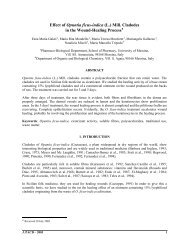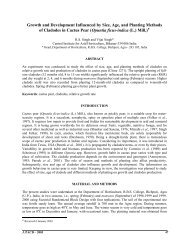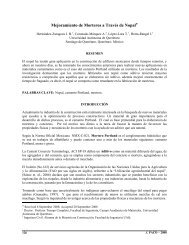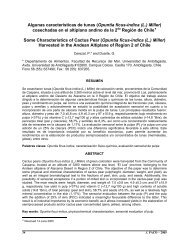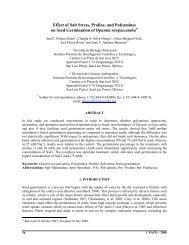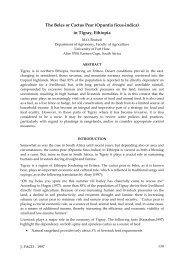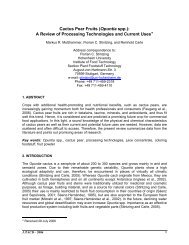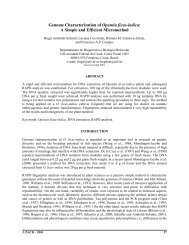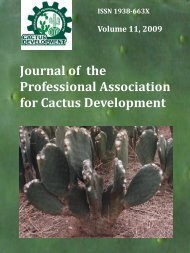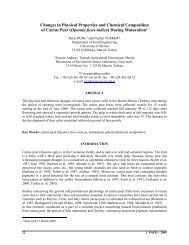In Vitro propagation of Pilosocereus robinii - Journal of the ...
In Vitro propagation of Pilosocereus robinii - Journal of the ...
In Vitro propagation of Pilosocereus robinii - Journal of the ...
Create successful ePaper yourself
Turn your PDF publications into a flip-book with our unique Google optimized e-Paper software.
<strong>In</strong> <strong>Vitro</strong> <strong>propagation</strong> <strong>of</strong> <strong>Pilosocereus</strong> <strong>robinii</strong> (Lemaire) Byles et Rowley,<br />
endemic and endangered cactus<br />
Elisa Quiala 1* , Jesús Matos 2 , Grecia Montalvo 2 , Manuel de Feria 1 , Maité Chávez 1 , Alina Capote 1 ,<br />
Naivy Pérez 1 , Raúl Barbón 1 and Britta Kowalski 3<br />
1 <strong>In</strong>stituto de Biotecnología de Las Plantas, Universidad Central “Marta Abreu” de Las Villas.<br />
Carretera a Camajuaní km 5½, Santa Clara, CP 54 830, Cuba.<br />
* Author for correspondence; E-mail: elisa@ibp.co.cu<br />
2 Empresa Nacional para la Protección de la Flora y la Fauna.Unidad Sabana de Santa Clara.<br />
Carretera a Placetas km 5½, Santa Clara. Villa Clara. Cuba. Tel. 53 (42) 206285<br />
3<br />
<strong>In</strong>stitute for Land Use, University <strong>of</strong> Rostock, Faculty <strong>of</strong> Agricultural and Environmental Sciences,<br />
18051 Rostock, Germany<br />
Received 2 December, 2008; Accepted 10 January, 2009<br />
Abstract<br />
<strong>In</strong> vitro <strong>propagation</strong> systems by areole activation were developed for <strong>Pilosocereus</strong> <strong>robinii</strong> (Lemaire)<br />
Byles et Rowley, an endemic cactus <strong>of</strong> Cuban island in extinction danger. Seeds from mature fruits<br />
were collected under field conditions and disinfected with two concentration <strong>of</strong> NaOCl (1.0 and<br />
2.0%) and two time <strong>of</strong> disinfection (15 and 20 min). During germination a half- and full-strength<br />
MS basal medium were tested. The highest germination rate (92.8%) was reached when half MS<br />
basal medium were used. Shoot formation from areoles <strong>of</strong> in vitro-germinated plantlets was<br />
achieved in explants cultured in Murashige and Skoog (MS) basal medium supplemented with 30 g<br />
l -1 sucrose, 3.0 g l -1 Gelrite ® and three concentration <strong>of</strong> 6-Bencilaminopurine (4.44, 6.66 and 13.32<br />
µM). Shoot production in this proliferation medium was evaluated during three culture cycles.<br />
Proportionately proliferation rate increase with 6-BAP concentration, on <strong>the</strong> contrary shoots length<br />
decreased. The highest proliferation rate (8.9 shoots per explant) was reached employment 13.32<br />
µM <strong>of</strong> 6-BAP. On average, rooting efficiency was 100% in MS basal medium free <strong>of</strong> growth<br />
regulators. The frequency <strong>of</strong> survival <strong>of</strong> <strong>the</strong> plants once transferred to substrate composed <strong>of</strong> cattle<br />
manure rotted for eight months was on average 91.6%. Finally, 500 individual plants <strong>of</strong><br />
<strong>Pilosocereus</strong> <strong>robinii</strong> were transferred to nursery. We describe for <strong>the</strong> first time a system for <strong>the</strong><br />
production <strong>of</strong> multiple shoots by areole activation, as well as <strong>the</strong>ir rooting, acclimatization and<br />
nursery establishment <strong>of</strong> endangered and endemic specie, that are difficult to propagate by<br />
conventional methods.<br />
Key words: biodiversity conservation, cactaceae, micro<strong>propagation</strong>, threatened specie, tissue<br />
culture.<br />
Abbreviations: 6-BAP- 6-Bencilaminopurine<br />
18 J. PACD (2009) 11: 18−25
<strong>In</strong>troduction<br />
<strong>Pilosocereus</strong> <strong>robinii</strong> (Lemaire) Byles et Rowley is an endemic and endangered cactus from Cuban<br />
island (Borhidi and Muñiz, 1983). The <strong>In</strong>ternational Union for <strong>the</strong> Conservation <strong>of</strong> <strong>the</strong> Nature<br />
(UCIN) reports areas in Cuba <strong>of</strong> high conservation priority, mainly <strong>the</strong> <strong>Pilosocereus</strong> <strong>robinii</strong> habitat.<br />
The area extends over <strong>the</strong> North coast from Rincón Francés to Camagüey, where natural flora has<br />
been adversely affected due to <strong>the</strong> tourist development.<br />
The seeds germination rate in this specie is low, and <strong>the</strong>ir growth is slow. Propagation by stem<br />
cuttings is inefficient; <strong>the</strong> donor plant must be mutilated to obtain a new individual with <strong>the</strong><br />
additional risk <strong>of</strong> fungal infection <strong>of</strong> <strong>the</strong> cut tissue and subsequent loss through rotting. For <strong>the</strong>se<br />
reasons it is difficult to recover endangered populations through conventional <strong>propagation</strong> methods.<br />
Therefore, it is necessary to safeguard <strong>the</strong>se species and to improve, in any possible way, existing<br />
<strong>propagation</strong> techniques.<br />
Tissue culture techniques have been applied successfully in <strong>the</strong> recovery and in vitro <strong>propagation</strong> <strong>of</strong><br />
different cacti species such as: Opuntia (Escobar et al., 1986), Cereus peruvianus Mill (Oliveira et<br />
al., 1995), 21 species <strong>of</strong> Mexican Cacti (Pérez Molphe-Balch et al., 1998), Opuntia ficus-indica<br />
(Pinheiro da Costa et al., 2001), Pelecyphora aselliformis Ehrenberg and P. strobiliformis<br />
Werdermann (Pérez Molphe-Balch and Dávila-Figueroa, 2002), Ariocarpus kotschoubeyanus<br />
(Lem) K. Schum (Moebius-Goldammer et al., 2003), different species <strong>of</strong> Turbinocarpus (Mata-<br />
Rosas et al. 2001; Dávila-Figueroa et al., 2005), Notocactus magnificus (Gallo et al., 2005),<br />
Mammillaria albicoma (Wyka et al., 2006).<br />
<strong>In</strong> <strong>the</strong> present study, we describe for <strong>the</strong> first time an in vitro <strong>propagation</strong> system for <strong>Pilosocereus</strong><br />
<strong>robinii</strong>, endangered and endemic Cuban specie <strong>of</strong> cacti. We refer seeds disinfection and<br />
germination, <strong>the</strong> production <strong>of</strong> multiple shoots by areole activation, as well as <strong>the</strong>ir rooting,<br />
acclimatization and nursery establishment. This system could become valuable tools for<br />
conservation and rescue <strong>of</strong> this specie.<br />
Materials and methods<br />
Plant material: Botanical seeds <strong>of</strong> <strong>Pilosocereus</strong> <strong>robinii</strong> were obtained from mature fruits collected<br />
in <strong>the</strong>ir natural habitat from several different plants (Figure 1).<br />
Seeds disinfection and germination: Seeds were washed with water and <strong>the</strong>n disinfected in two<br />
concentrations <strong>of</strong> Sodium Hypochlorite (1.0 and 2.0%), two times <strong>of</strong> disinfection (15 and 20 min)<br />
were tested. Seeds were placed singly in test tubes with 10 ml <strong>of</strong> incubation MS basal medium<br />
Murashige and Skoog (1962), 10 g l -1 sucrose, pH 5.6 and solidified with 2.0 g.l -1 Gelrite®. After<br />
10 days <strong>of</strong> culture <strong>the</strong> number <strong>of</strong> seeds free <strong>of</strong> microbial contaminants was evaluated and seeds <strong>the</strong>n<br />
placed on germination media. During germination a half- and full-strength MS basal medium<br />
supplemented with 1.0 mg l -1 thiamine, 30 mg l -1 sucrose and 2.0 g l -1 Gelrite ® were proved. Seed<br />
germination was evaluated on alternate days during seven weeks.<br />
The cultures were maintained on a growth chambers with solar light 48.1-62.5 µE.m -2 s -1 at 28±2ºC.<br />
These same conditions were used in all subsequent experiments.<br />
J. PACD (2009) 11: 18–25 19
a<br />
Figure 1 a) Plant <strong>of</strong> <strong>Pilosocereus</strong> <strong>robinii</strong> in natural habitat (“Cayo Conuco”, north coast <strong>of</strong> <strong>the</strong><br />
island), b) mature fruit opened, c) seed collected from mature fruit.<br />
Axillary shoot proliferation and rooting: The proliferation was carried out by means <strong>of</strong> axillary<br />
buds activation. For this, <strong>the</strong> root systems were excised and each cactus was cut transversely and<br />
both <strong>the</strong> apex and <strong>the</strong> base were placed into culture flask, containing 25 ml <strong>of</strong> full-strength MS<br />
basal media with 30 g l -1 sucrose, 1.0 mg l -1 thiamine, 100 mg l -1 myo-inositol, 3.0 g l -1 Gelrite® and<br />
three concentrations (4.44, 6.66 and 13.32 (uM) <strong>of</strong> 6 BAP. Twenty explants per treatment were<br />
used. The number <strong>of</strong> shoots produced per plant and <strong>the</strong> length <strong>of</strong> shoots were recorded after 7 wk <strong>of</strong><br />
culture during three culture cycle (21 wk).<br />
Shoots were collected from shoot proliferation media and used for rooting. The rooting technique<br />
consisted <strong>of</strong> transferring <strong>the</strong> shoots to MS basal medium free <strong>of</strong> growth regulators with 30 g l -1<br />
sucrose and 3.0 g l -1 Gelrite®. The number <strong>of</strong> plants with roots was evaluated 8 wk after initiating<br />
this phase.<br />
Acclimatization and transfer <strong>of</strong> plantlets to nursery: Rooted plants were transplanted to pots<br />
containing two type <strong>of</strong> substrate. Substrate 1 was composed by 100% <strong>of</strong> cattle manure with eight<br />
months <strong>of</strong> decomposition covered with a 2.0 cm layer <strong>of</strong> zeolite. Substrate 2 was composed <strong>of</strong> 85%<br />
compost mixed with 15% zeolite. Plastic covering were used to reduce 50% <strong>of</strong> luminous intensity<br />
<strong>of</strong> solar light and to allow acclimatization plants before being transferred to <strong>the</strong> nursery. Survival<br />
percentages were determined 10 wk after transplantation. Finally plants were transferred to nursery<br />
and planted onto plastic bags containing a 2:2:1 (v/v) mixture <strong>of</strong> cattle manure, soil from <strong>the</strong> natural<br />
habitat and ground lime stone.<br />
20 J. PACD (2009) 11: 18−25<br />
b<br />
c
Experimental design and data analysis: Each experiment was repeated three times. All data<br />
collected was compared through analysis <strong>of</strong> variance. Means values were compared by Duncan<br />
multiple range test at <strong>the</strong> 5% level (p < 0.05).<br />
Results and discussion<br />
Seeds disinfection and germination<br />
The sodium hypochlorite was effective for <strong>the</strong> disinfection <strong>of</strong> seeds; a 100% <strong>of</strong> seeds free <strong>of</strong><br />
microbial contaminants were obtained when 2.0% <strong>of</strong> sodium hypochlorite for 20 minutes was used.<br />
When 2.0% <strong>of</strong> NaOCl for 15 minutes was applied, an 80% <strong>of</strong> seeds free <strong>of</strong> microbial contaminant<br />
were reached in this treatment (Figure 2). The seeds <strong>of</strong> <strong>Pilosocereus</strong> <strong>robinii</strong> are small (2-3 mm)<br />
with a hard and flat texture <strong>of</strong>fering little coverage for <strong>the</strong> development <strong>of</strong> microorganisms.<br />
Figure 2. Effects <strong>of</strong> Sodium Hypochlorite in <strong>the</strong> seeds disinfestations <strong>of</strong> <strong>Pilosocereus</strong> <strong>robinii</strong>.<br />
Bars with different letters are significantly different at p=0.05. Data are means ± SE (n =14).<br />
Germination occurred gradually starting 14 d after <strong>the</strong> inoculation <strong>of</strong> seeds, achieving a high<br />
percentage, in <strong>the</strong> culture medium with half-strength MS basal medium (Figure 3). <strong>In</strong> <strong>the</strong> fullstrength<br />
MS basal media, germination was inferior and started one week later.<br />
Axillary shoot proliferation and rooting<br />
The cytokinin was indispensable for shoot generation through areole activation. The control<br />
treatments without 6-BAP were unable to induce shoot proliferation. On <strong>the</strong> contrary, when<br />
cytokinin was included in <strong>the</strong> culture media, shoots were obtained in all treatments.<br />
After 4 weeks <strong>the</strong> explants exhibited shoot production from <strong>the</strong> areoles in all treatments containing<br />
6-BAP. <strong>In</strong> <strong>the</strong> range <strong>of</strong> concentrations used, proportionately proliferation rate increase with 6-BAP<br />
concentration, on <strong>the</strong> contrary shoots length decreased.<br />
J. PACD (2009) 11: 18–25 21
Figure 3. Effects <strong>of</strong> half-strength and full-strength MS basal medium in <strong>the</strong> seeds germination <strong>of</strong><br />
<strong>Pilosocereus</strong> <strong>robinii</strong>. Bars with different letters are significantly different at p=0.05.<br />
Data are means ± SE (n =14).<br />
When apical explants were used, a dominant shoot arises from <strong>the</strong> elongation <strong>of</strong> <strong>the</strong> inoculated<br />
apex, and <strong>the</strong> small shoots appear at its base. While when <strong>the</strong> base <strong>of</strong> cactus was used as primary<br />
explant, <strong>the</strong> shoots generated were homogeneous in <strong>the</strong>ir size and differentiation stage and appeared<br />
in <strong>the</strong> upper part <strong>of</strong> <strong>the</strong> explants, <strong>the</strong>se shoots were easily separated and subculture (Figure 4a). So<br />
that in this specie is indispensable to eliminate <strong>the</strong> apical dominance to produce new shoots with<br />
desirable characteristic to subculture. Although <strong>the</strong> highest proliferation rate (8.9 shoots per<br />
explant) (Table 1) was reached with <strong>the</strong> higher concentration (13.32 µM 6-BAP) we observed in<br />
this treatment shoots with hyperhydration symptoms.<br />
Table 1. Effects <strong>of</strong> 6-BAP concentration on shoot proliferation by areole activation<br />
in <strong>Pilosocereus</strong> <strong>robinii</strong>.<br />
Growth regulators<br />
( µM 6-BAP )<br />
Shoots per explant in each culture cycle*<br />
First cycle (7 wk) Second cycle (14 wk) Third cycle (21 wk)<br />
none 1.00 c 1.30 d 1.80 d<br />
4.44 2.10 b 3.37 c 4.30 c<br />
6.66 2.92 a 4.41 b 5.62 b<br />
13.32 3.30 a 5.53 a 8.93 a<br />
±SE £ 0.29 0.37 0.41<br />
£ SE: Standard Error. Data were collected from 20 initiated shoots per treatment in each culture cycle.<br />
*Means followed by <strong>the</strong> same letter within each column do not differ significantly at p≤ 0.05 according to <strong>the</strong><br />
Duncan multiple range test.<br />
22 J. PACD (2009) 11: 18−25
According to different authors (Elias-Rocha et al., 1998; Pérez-Molphe-Balch et al., 1998)<br />
hyperhydration <strong>of</strong> <strong>the</strong> tissues is a serious problem for in vitro culture <strong>of</strong> cacti. This physiological<br />
disorder is due to <strong>the</strong> physical and chemical conditions <strong>of</strong> in vitro culture; i.e. high humidity, excess<br />
<strong>of</strong> carbohydrates and minerals, high levels <strong>of</strong> plant growth regulators and low light intensity (Ziv,<br />
1991). <strong>In</strong> this work, hyperhydration was present, only when higher concentrations <strong>of</strong> 6-BAP in <strong>the</strong><br />
proliferation media where used. The 6.66 µM 6-BAP treatment would be more convenient to use<br />
for shoot proliferation <strong>of</strong> <strong>Pilosocereus</strong> <strong>robinii</strong> to avoid <strong>the</strong> adverse effect <strong>of</strong> higher levels <strong>of</strong> 6-BAP,<br />
such as hyperhydricity and somaclonal variation.<br />
The positive effect <strong>of</strong> 6-BAP on <strong>the</strong> capacity to induce plant regeneration in cactaceae has been<br />
reported previously for species in o<strong>the</strong>r cacti genera, also by areole activation for shoot<br />
proliferation. Pérez-Molphe-Balch et al. (1998) report a range from 2.1 to 17.5 shoots per explant in<br />
a study conducted on 21 species in 10 genera <strong>of</strong> Cactaceae. Elias-Rocha et al. (1998) refer seven<br />
shoots per explant for Mammillaria sphacelata. There are also reports <strong>of</strong> 13.7 and 12.3 shoots per<br />
explant in Pelecyphora aselliformis and P. strobiliformis, respectively. Pérez-Molphe-Balch and<br />
Dávila-Figueroa (2002) refers 5.3, 3.8, and 4.3 shoots per explant in Carnegiea gigantea,<br />
Pachycereus pringlei, and Stenocereus thurberi, respectively.<br />
Although on average, rooting efficiency was 100% and <strong>the</strong> in vitro-generated roots were vigorous<br />
in a basal MS media free <strong>of</strong> growth regulator (Figure 4b), shoots coming from proliferation media<br />
with 6.66 and 13.32 µM 6-BAP, rooted one week later than those coming from treatment without or<br />
with 4.44 µM 6-BAP.<br />
Maintaining genetic stability in regenerated plants is essential for endangered species conservation.<br />
It is important that shoots proliferation in <strong>Pilosocereus</strong> <strong>robinii</strong> was from areole activation, because<br />
according to Machado and Prioli (1996) as well as Pérez-Molphe-Balch and Dávila-Figueroa (2002)<br />
micropropagated cacti regenerated from axillary buds are considered to be genetically stable.<br />
Acclimatization and transfer <strong>of</strong> plantlets to nursery<br />
The acclimatization <strong>of</strong> plants was successful. The biggest survival rate (91.6%) was obtained in <strong>the</strong><br />
substrate with 100% <strong>of</strong> cattle manure covered with zeolite (Figure 4c), while 66% <strong>of</strong> survival rate<br />
was achieved when <strong>the</strong> substrate with 85% compost and 15% zeolite was used. <strong>In</strong> this treatment<br />
fungal infection in <strong>the</strong> base <strong>of</strong> cactus was observed and subsequent loss through rotting.<br />
<strong>In</strong> Cuba, according to <strong>the</strong> experience <strong>of</strong> <strong>the</strong> National Botanical Garden, a complex mixture<br />
composed by 35% <strong>of</strong> well washed thick sand, 15% <strong>of</strong> rotten earth, 35% <strong>of</strong> humus and 15% <strong>of</strong><br />
charcoal is recommended for <strong>the</strong> sowing <strong>of</strong> cactus. However, according to <strong>the</strong> experience obtained<br />
in this work, with a simple substrate composed by cattle manure with eight months <strong>of</strong><br />
decomposition it is feasible <strong>the</strong> culture <strong>of</strong> this cactus species, with a high percentage <strong>of</strong> survival in<br />
acclimatization. Applying <strong>the</strong> methodology described in this work, 500 plants <strong>of</strong> <strong>Pilosocereus</strong><br />
<strong>robinii</strong> has been transferred to <strong>the</strong> protected area and planted in nursery conditions with 100%<br />
survival rate (Figure 4d).<br />
Conclusions<br />
A protocol for in vitro <strong>propagation</strong> <strong>of</strong> <strong>Pilosocereus</strong> <strong>robinii</strong> was established. This protocol is more<br />
efficient than traditional <strong>propagation</strong> methods and can be valuable tool for <strong>the</strong> in vitro conservation<br />
<strong>of</strong> this specie, and <strong>the</strong> production <strong>of</strong> plants for <strong>the</strong> repopulation <strong>of</strong> natural areas damaged during<br />
construction <strong>of</strong> tourist facilities.<br />
J. PACD (2009) 11: 18–25 23
a<br />
c d<br />
Figure 4. <strong>In</strong> vitro <strong>propagation</strong> <strong>of</strong> <strong>Pilosocereus</strong> <strong>robinii</strong>, a) Shoot production by areole<br />
activation with 6.66 µM 6-BAP after 7 wk <strong>of</strong> culture initiation, b) Shoots rooted<br />
after 8 wk culture in full-strength MS basal media free <strong>of</strong> growth regulators,<br />
c) <strong>In</strong> vitro-generated plants growing in 100% cattle manure with eight<br />
months <strong>of</strong> decomposition covered with a 2.0 cm layer <strong>of</strong> zeolite<br />
after 70 days, d) <strong>In</strong> vitro-generated plants in nursery<br />
conditions after six months.<br />
Acknowledgements<br />
This work was supported by <strong>the</strong> Union <strong>of</strong> Universities <strong>of</strong> Latin America (UDUAL). We express our<br />
sincere thanks to Ph. D. Yelenys Alvarado Capó and M. Sc. Osmildo Fernández for critical reading<br />
<strong>of</strong> this manuscript. We would also like to thank Dr. Martín Mata Rosas and Ph. D. Eugenio Pérez<br />
Molphe Balch for <strong>the</strong> scientific literature <strong>the</strong>y supplied.<br />
References<br />
Borhidi, A. and Muñiz, O. 1983. Catálogo de Plantas cubanas amenazadas o extinguidas. Editorial<br />
de la Academia de Ciencias de Cuba, La Habana, Cuba. p. 17.<br />
24 J. PACD (2009) 11: 18−25<br />
b
Elias-Rocha M.A., Santos-Días M.S., Arredondo-Gómez, A. 1998. Propagation <strong>of</strong> Mammillaria<br />
candida (Cactaceae) by tissue culture technique. Haseltonia 6:96–101.<br />
González-Benito, M.E., Martín, C., Iriondo, J.M., Pérez, C. 1999. Conservation <strong>of</strong> <strong>the</strong> Rare and<br />
Endangered Plants Endemic to Spain. <strong>In</strong>: Plant Conservation Biotechnology. Benson, E. (Ed.).<br />
Taylor & Francis, London. pp. 251-264.<br />
Oliveira, S.A., Machado, M.F.P.S., Prioli, A.J. 1995. <strong>In</strong> vitro <strong>propagation</strong> <strong>of</strong> Cereus peruvianus<br />
Mill (Cactaceae). <strong>In</strong> <strong>Vitro</strong> Cell. Dev. Biol. Plant 31:47–50.<br />
Machado, M.F.P.S. and Prioli, A.J. 1996. Micro<strong>propagation</strong> <strong>of</strong> Cereus peruvianus Mill. (Cactaceae)<br />
by areole activation. <strong>In</strong> <strong>Vitro</strong> Cell. Dev. Biol. Plant 32:199–203.<br />
Mata-Rosas, M., Monroy de la Rosa, M.A., Goldammer, K.M., Chávez-Avila, V.M. 2001.<br />
Micro<strong>propagation</strong> <strong>of</strong> Turbinicarpus laui, an endemic and endangered species. <strong>In</strong> <strong>Vitro</strong> Cell. Dev.<br />
Biol. Plant 37: 400–404.<br />
Moebius-Goldammer, K. G., Mata-Rosas, M. and Chávez-Avila, V. M. 2003. Organogenesis and<br />
somatic embryogenesis in Ariocarpus kotschoubeyanus (Lem.) K. Schum. (Cactaceae), an endemic<br />
and endangered Mexican species. <strong>In</strong> <strong>Vitro</strong> Cell. Dev. Biol. Plant. 39: 388-393.<br />
Murashige, T. and Skoog, F. 1962. A revised medium for rapid growth and bioassays with tobacco<br />
tissue cultures. Physiol. Plant. 15:473–497.<br />
Pérez-Molphe-Balch E,, Pérez-Reyes, M. E., Villalobos-Amador, E., Meza-Rangel, E., Morones-<br />
Ruiz, L.R., Lizalde-Viramontes, H. 1998. Micro<strong>propagation</strong> <strong>of</strong> 21 species <strong>of</strong> Mexican Cacti by<br />
axillary proliferation. <strong>In</strong> <strong>Vitro</strong> Cell. Dev. Biol. Plant 34:131–135.<br />
Pérez-Molphe-Balch, E., Dávila-Figueroa, C.A. 2002. <strong>In</strong> vitro <strong>propagation</strong> <strong>of</strong> Pelecyphora<br />
aselliformis Ehrenberg and P. strobiliformis Werdermann (Cactaceae). <strong>In</strong> <strong>Vitro</strong> Cell. Dev. Biol.<br />
Plant 38:73–78.<br />
Pinheiro da Costa, S., Soares, A.A., Arnholdt-Schmitt, B. 2001. Studies on <strong>the</strong> induction <strong>of</strong><br />
embryogenic globular structures in Opuntia ficus-indica. <strong>Journal</strong> <strong>of</strong> <strong>the</strong> Pr<strong>of</strong>essional Association<br />
for Cactus Development 4: 66-74.<br />
Wyka, P.T., Hamerska, M. and Wrablewska, M. 2006. Organogenesis <strong>of</strong> vegetative shoots from in<br />
vitro cultured flower buds <strong>of</strong> Mammillaria albicoma (Cactaceae). Plant Cell, Tissue and Organ<br />
Culture 87: 27-32.<br />
Ziv, M. 1991. Vitrification: morphological and physiological disorders <strong>of</strong> in vitro plants. <strong>In</strong>:<br />
Debergh, P.C. and Zimmerman, R.H. (Eds.). Micro<strong>propagation</strong> Technology and application.<br />
Dordrecht: Kluwer Academic Publisher. pp. 45–6.<br />
J. PACD (2009) 11: 18–25 25



